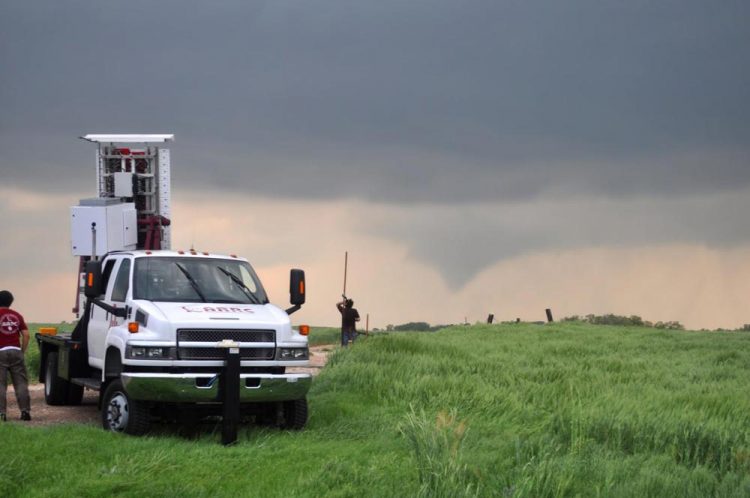SimRadar: A polarimetric radar time-series simulator for tornadic debris studies

A University of Oklahoma research team with the Advanced Radar Research Center has developed the first numerical polarimetric radar simulator to study and characterize scattering mechanisms of debris particles in tornadoes. Credit: University of Oklahoma
“These results are important for operational weather forecasters and emergency managers,” says Nick Anderson, program director in the National Science Foundation Division of Atmospheric and Geospace Sciences, which funded the research. “An improved understanding of what weather radars tell us about tornado debris can help provide more accurate tornado warnings, and quickly direct emergency personnel to affected areas.”
“With this simulator, we can explain in great detail to the operational weather community the tornadic echo from the polarimetric radar,” said Robert Palmer, ARRC executive director. “The signal received by the dual polarimetric radar is not easily understood because rain is mixed with the debris. The knowledge we gain from this study will improve tornado detection and near real-time damage estimation.”
Numerous controlled anechoic chamber measurements of tornadic debris were conducted at the Radar Innovations Laboratory on the OU Research Campus to determine the scattering characteristics of several debris types–leaves, shingles and boards.
Palmer, D.J. Bodine, B.L.Cheong, C.J. Fulton and S.M. Torres, the center, and the OU Schools of Electrical and Computer Engineering and Meteorology, developed the simulator to provide comparisons for actual polarimetric radar measurements.
Before this study, there were many unanswered questions related to tornado debris scattering, such as knowing how the size, concentration and shape of different debris types affect polarimetric variables. How the radar identifies the debris is equally as important.
Orientation of debris makes a difference as well as how the debris falls through the atmosphere. Overall, understanding debris scattering characteristics aid in the discovery of the relationship between debris characteristics, such as lofting and centrifuging, and tornado dynamics.
OU team members were responsible for various aspects of this study. Coordination of damage surveys and collection of debris samples were led by Bodine. Field experiments were designed by team members in collaboration with Howard Bluestein, OU School of Meteorology. Electromagnetic simulations and anechoic chamber experiments were led by Fulton. The signal processing algorithms were developed by Torres and his team. Cheong led the simulation development team.
###
The study, “SimRadar: A Polarimetric Radar Time-Series Simulator for Tornadic Debris Studies,” will be published in the May issue of the Institute of Electrical and Electronics Engineers Transactions on Geoscience and Remote Sensing. This work is supported by the National Science Foundation with grant number AGS-1303685. There were significant results from the collaboration between the center and the Disaster Prevention Research Institute in Kyoto University.
Note to editors: An animation has been developed for the simulation of the three types of tornadic debris used in this study, which included leaves (green), shingles (pink) and boards (orange). The OU team has the ability, however, to simulate other types of debris. Download the animation at https:/
Media Contact
All latest news from the category: Earth Sciences
Earth Sciences (also referred to as Geosciences), which deals with basic issues surrounding our planet, plays a vital role in the area of energy and raw materials supply.
Earth Sciences comprises subjects such as geology, geography, geological informatics, paleontology, mineralogy, petrography, crystallography, geophysics, geodesy, glaciology, cartography, photogrammetry, meteorology and seismology, early-warning systems, earthquake research and polar research.
Newest articles

Silicon Carbide Innovation Alliance to drive industrial-scale semiconductor work
Known for its ability to withstand extreme environments and high voltages, silicon carbide (SiC) is a semiconducting material made up of silicon and carbon atoms arranged into crystals that is…

New SPECT/CT technique shows impressive biomarker identification
…offers increased access for prostate cancer patients. A novel SPECT/CT acquisition method can accurately detect radiopharmaceutical biodistribution in a convenient manner for prostate cancer patients, opening the door for more…

How 3D printers can give robots a soft touch
Soft skin coverings and touch sensors have emerged as a promising feature for robots that are both safer and more intuitive for human interaction, but they are expensive and difficult…




















